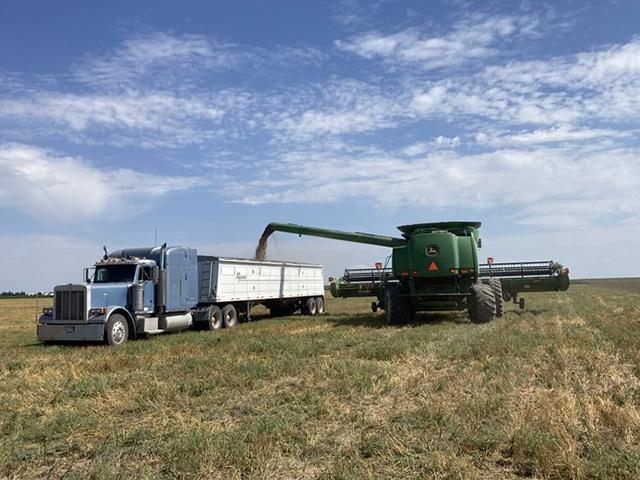Market Matters Blog
Kansas Winter Wheat Harvest Crawls to Finish Line
Hard red winter (HRW) wheat harvest in Kansas typically begins in early to mid-June and is complete by mid-July, but that hasn't happened this year, as the harvest is behind average.
"We finally started the 2023 wheat harvest today (July 10)," said western Kansas wheat farmer Dan Moomaw. "Only about three weeks later than normal. July 10 is the latest we have ever started." As of July 10, USDA said 59% of the crop had been harvested compared to the 84% average.
Moomaw wasn't alone in experiencing a delayed harvest. For the week ended July 16, USDA said Kansas was 71% harvested versus the five-year average of 94%.
"The biggest struggle we had here was with weeds in the wheat. Due to last year's record drought, the wheat stand when we planted last fall was somewhat marginal," said Moomaw. "The thin stand of wheat led to an invasion of weeds in the wheat this spring even though we sprayed on Rave in the spring to try and suppress them."
P[L1] D[0x0] M[300x250] OOP[F] ADUNIT[] T[]
Moomaw added, "The two-to-three-week late harvest, combined with way-above-normal rain for June, combined to make the perfect storm for weeds. We sprayed the fields we wanted to save for seed wheat and gutted it out cutting the rest. Most of our neighbors did the same thing. The yields were probably about 40% of what we would hope for in a normal year. Surprisingly, the test weights stayed right around the 60-pound-per-bushel mark."
"The western Kansas weather pattern did a 180 starting in mid-May, from no rain for six to nine months to repeated storms that brought a year's worth of precipitation in a four- to six-week period," said Kansas Wheat CEO Justin Gilpin. "The moisture and cooler weather have been beneficial in replenishing soils and for spring-planted crops. Later wheat was also able to benefit in filling heads.
"But, as the rains continued, it brought on secondary tillers and sucker heads, creating a challenge in waiting for whole fields to dry down for harvest. Also, weed pressure began emerging through thin stands, creating another obstacle to deal with. Test weights and proteins early were good, but as combines sat idle waiting for rains to pass and fields to be ready, we've seen test weights decline from early weights of 60 pounds per bushel, to now a lot more at 58 pounds per bushel."
In their day 14 harvest report on July 21, Kansas Wheat noted: "The northwestern corner of the state was among the few that received moisture last fall, snow this winter and rain this spring, leading to better yields than many other areas of the state. In contrast, the southwest corner of the state is faring poorer with high rates of abandonment and declining conditions for wheat left standing in the field. Universally, moisture in the air continues to delay cutting, extending harvest well beyond a normal pace."
USDA, in its May 14-20 weekly weather and crop bulletin, noted: "Based on preliminary statistics provided by USDA-NASS, U.S. winter wheat abandonment for 2023 is pegged at 32.6%. If realized, this would be the nation's highest winter wheat abandonment rate since 1917. In fact, since abandonment reached 28.6% in 1951, the only years more than one-quarter of the winter wheat was abandoned were 2002, with 28.8%, and 2022, with 29.5%."
Since that report mentioned above, there have been more aces abandoned in Kansas due not just to drought, but severe weather that caused some fields to be hailed out. Ben Rand, an insurance agent for the Home Agency and Blue Line Futures and a commodity broker, said that one-third of the Kansas HRW wheat crop was abandoned after being appraised between zero and 8 bushels per acre. "Those farmers took the appraisal and abandoned it. This wheat can no longer be harvested, even if it is good. If they do harvest it, they are required to report the production, and their insurance check will be adjusted accordingly."
Gilpin added, "There have also been some incidents of sprout damage that farmers and elevators are monitoring as anxiety is building to reach the finish line of harvest."
For more, see "Wheat Abandonment Could Be Most Since World War I" by DTN Ag Meteorologist Emeritus Bryce Anderson here: https://www.dtnpf.com/….
Mary Kennedy can be reached at Mary.Kennedy@dtn.com
Follow her on Twitter @MaryCKenn
(c) Copyright 2023 DTN, LLC. All rights reserved.






Comments
To comment, please Log In or Join our Community .